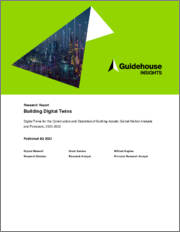
|
시장보고서
상품코드
1697412
건설업용 디지털 트윈 시장 : 예측(2025-2030년)Digital Twin in Construction Market - Forecasts from 2025 to 2030 |
||||||
건설업용 디지털 트윈 시장은 예측 기간 동안 CAGR 17.03%의 강력한 성장세를 보이며 2025년 648억 6,500만 달러에서 2030년 1,550억 1,000만 달러에 달할 것으로 예상됩니다.
건설업용 디지털 트윈은 3D 레이저 스캐너, 드론, 센서, 카메라, 기타 IoT 장치 등의 기술을 활용하여 실제 데이터를 수집하고 합성하여 생성되며, IoT와 AI를 통해 구현된 디지털 트윈은 다양한 소스에서 자율적으로 학습하고 물리적 속성(형상, 위치, 제스처, 움직임), 상호 작용, 수정 사항을 반영하여 동적으로 업데이트할 수 있습니다. 모양, 위치, 제스처, 움직임), 상호작용, 수정을 반영하여 실제 세계의 대응물을 미러링하도록 동적으로 업데이트할 수 있습니다. 이 데이터에는 객체의 특성과 상태에 대한 정보가 포함됩니다. 디지털 트윈을 빌딩 정보 모델링(BIM) 프로세스에 통합함으로써 계약자 및 건축/엔지니어링 회사는 성능 저하, 수익성 저하, 오류 및 사고율 증가와 같은 업계의 심각한 문제를 해결할 수 있습니다. 또한, 디지털 트윈은 입찰의 정확성을 높이면서 가상 설계 및 건설 비용 절감을 촉진합니다. 프로젝트 팀은 물리적 건축물과 구조물, 작업 현장에 변경을 가하기 전에 예상 결과를 디지털로 테스트하고 분석할 수 있습니다.
건설업용 디지털 트윈 시장의 성장은 몇 가지 주요 요인에 의해 촉진되고 있습니다. 주요 촉진요인은 클라우드 기반 플랫폼의 채택이 증가하고 있다는 점입니다. 클라우드 기반 플랫폼은 실시간 데이터 수집 및 분석을 위한 견고한 기반을 제공하며, 점점 더 복잡해지는 물리적 자산의 디지털 모델을 구축하는 데 필수적입니다. 클라우드 플랫폼의 확장성과 접근성은 디지털 트윈 솔루션의 구현을 간소화하며, 주요 클라우드 제공업체들은 종합적인 디지털 트윈 기능을 도입하고 있습니다. 예를 들어, 마이크로소프트는 빌딩 관리 및 건설을 위한 디지털 트윈 온톨로지를 제공하고 있습니다. 또한, 재정적 지원과 규제 프레임워크를 통해 건설 분야에서 첨단 기술 채택을 장려하는 정부의 노력이 전 세계적으로 증가하고 있는 것도 큰 계기가 되고 있습니다.
건설업용 디지털 트윈 시장은 지역별로 다양한 성장 패턴을 보이고 있습니다. 북미 시장은 첨단 기술 통합, 숙련된 인력, 지원적인 규제 환경으로 인해 성장하고 있습니다. 유럽에서는 빅데이터 분석, IoT, 인공지능(AI), 머신러닝(ML) 등 기술의 출현과 인더스트리 4.0 기술이 성장을 촉진하고 있습니다. 아시아태평양 시장은 기술 발전, 생산량 증가, 디지털 네트워크의 확대가 성장의 원동력이 되고 있습니다. 마지막으로 남미, 중동 및 아프리카는 기술 발전을 촉진하는 정부 이니셔티브의 증가에 힘입어 큰 폭의 성장이 예상됩니다.
이 보고서를 구매해야 하는 이유
- 통찰력 있는 분석 : 고객 부문, 정부 정책 및 사회경제적 요인, 소비자 선호도, 산업별, 기타 하위 부문에 초점을 맞추고 주요 지역뿐만 아니라 신흥 지역까지 포괄하는 상세한 시장 인사이트를 얻을 수 있습니다.
- 경쟁 상황 : 세계 주요 기업들이 채택하고 있는 전략적 전략을 이해하고, 적절한 전략을 통한 시장 침투 가능성을 파악할 수 있습니다.
- 시장 촉진요인과 미래 동향 : 역동적인 요인과 매우 중요한 시장 동향, 그리고 이들이 향후 시장 발전을 어떻게 형성할 것인지에 대해 알아봅니다.
- 실행 가능한 제안 : 역동적인 환경 속에서 새로운 비즈니스 스트림과 수익을 발굴하기 위한 전략적 의사결정에 인사이트를 활용합니다.
- 다양한 사용자에 대응 : 스타트업, 연구기관, 컨설턴트, 중소기업, 대기업에 유익하고 비용 효율적입니다.
어떤 용도로 사용되는가?
산업 및 시장 인사이트, 사업 기회 평가, 제품 수요 예측, 시장 진입 전략, 지리적 확장, 설비 투자 결정, 규제 프레임워크와 영향, 신제품 개발, 경쟁의 영향
분석 범위
- 과거 데이터 및 예측(2022-2030년)
- 성장 기회, 도전과제, 공급망 전망, 규제 프레임워크, 고객 행동, 트렌드 분석
- 경쟁사 포지셔닝, 전략 및 시장 점유율 분석
- 매출 성장률 및 예측 분석 : 부문별/지역별(국가별)
- 기업 프로파일링(전략, 제품, 재무정보, 주요 동향 등)
건설업용 디지털 트윈 시장은 다음과 같은 부문별로 분석됩니다:
종류별
- 정보형 트윈
- 자율형 트윈
구성요소별
- 소프트웨어
- 하드웨어
용도별
- 자원 관리 및 물류
- 안전 모니터링
- 제품 설계 및 최적화
- 품질 관리
- 예지보전
- 기타
지역별
- 북미
- 미국
- 캐나다
- 멕시코
- 남미
- 브라질
- 아르헨티나
- 기타
- 유럽
- 미국 영국
- 독일
- 프랑스
- 스페인
- 기타
- 중동 및 아프리카
- 사우디아라비아
- UAE
- 기타
- 아시아태평양
- 중국
- 일본
- 인도
- 한국
- 대만
- 기타
목차
제1장 주요 요약
제2장 시장 현황
- 시장 개요
- 시장 정의
- 조사 범위
- 시장 세분화
제3장 비즈니스 상황
- 시장 성장 촉진요인
- 시장 성장 억제요인
- 시장 기회
- Porter's Five Forces 분석
- 업계 밸류체인 분석
- 정책과 규제
- 전략적 추천사항
제4장 기술 전망
제5장 건설업용 디지털 트윈 시장 : 종류별
- 소개
- 정보형 트윈
- 자율형 트윈
제6장 건설업용 디지털 트윈 시장 : 구성요소별
- 소개
- 하드웨어
- 소프트웨어
제7장 건설업용 디지털 트윈 시장 : 용도별
- 소개
- 자원 관리·물류
- 안전 모니터링
- 제품 설계·최적화
- 품질 관리
- 예지보전
- 기타
제8장 건설업용 디지털 트윈 시장 : 지역별
- 소개
- 북미
- 종류별
- 구성요소별
- 용도별
- 국가별
- 남미
- 종류별
- 구성요소별
- 용도별
- 국가별
- 유럽
- 종류별
- 구성요소별
- 용도별
- 국가별
- 중동 및 아프리카
- 종류별
- 구성요소별
- 용도별
- 국가별
- 아시아태평양
- 종류별
- 구성요소별
- 용도별
- 국가별
제9장 경쟁 환경과 분석
- 주요 기업과 전략 분석
- 시장 점유율 분석
- 기업 인수합병(M&A), 합의, 사업 협력
- 경쟁 대시보드
제10장 기업 개요
- ANSYS
- GE Vernova
- IBM
- Microsoft
- Siemens
- Bentley Systems
- Digital Twin Consortium
- Cisco
- Oracle
제11장 부록
- 통화
- 가정
- 기준 연도와 예측 연도 타임라인
- 이해관계자에 대한 주요 이점
- 조사 방법
- 약어
The Digital Twin in Construction market is set to witness robust growth at a CAGR of 17.03% during the forecast period, reaching a value of US$155.010 billion in 2030 from US$64.865 billion in 2025.
Digital twins in construction are created through the aggregation and synthesis of real-world data, leveraging technologies such as 3D laser scanners, drones, sensors, cameras, and other IoT devices. Enabled by IoT and AI, a digital twin can autonomously learn from disparate sources and dynamically update to mirror its real-world counterpart, reflecting physical attributes (shape, position, gesture, motion), interactions, and modifications. This data encompasses information on the properties and states of an object. By integrating digital twins into Building Information Modeling (BIM) processes, contractors and architecture/engineering firms can address critical industry challenges, including underperformance, low profitability, and elevated error and accident rates. Furthermore, digital twins facilitate the reduction of virtual design and construction costs while enhancing bidding accuracy. Project teams can digitally test and analyze anticipated outcomes before implementing changes to the physical construction, structure, or worksite.
The growth of the digital twin market in construction is fueled by several key factors. A primary driver is the increasing adoption of cloud-based platforms, which provide a robust foundation for real-time data collection and analysis, essential for establishing increasingly intricate digital models of physical assets. The scalability and accessibility of cloud platforms streamline the implementation of digital twin solutions, and major cloud providers have introduced comprehensive digital twin capabilities. For example, Microsoft offers its digital twin ontology for building management and construction. Another significant catalyst is the rise in government initiatives worldwide that incentivize the adoption of advanced technologies in construction through financial support and regulatory frameworks.
Geographically, the digital twin market in construction exhibits varying growth patterns. The North American market is expanding due to the integration of advanced technologies, a skilled workforce, and a supportive regulatory environment. In Europe, growth is propelled by the emergence of technologies such as big data analytics, IoT, artificial intelligence (AI), and machine learning (ML), coupled with Industry 4.0 technologies. The Asia-Pacific market is experiencing growth driven by technological advancements, increasing manufacturing output, and expanding digital networks. Finally, the South American, Middle Eastern, and African regions are anticipated to witness substantial growth, supported by increasing government initiatives that promote technological advancements.
Reasons for buying this report:-
- Insightful Analysis: Gain detailed market insights covering major as well as emerging geographical regions, focusing on customer segments, government policies and socio-economic factors, consumer preferences, industry verticals, other sub- segments.
- Competitive Landscape: Understand the strategic maneuvers employed by key players globally to understand possible market penetration with the correct strategy.
- Market Drivers & Future Trends: Explore the dynamic factors and pivotal market trends and how they will shape up future market developments.
- Actionable Recommendations: Utilize the insights to exercise strategic decision to uncover new business streams and revenues in a dynamic environment.
- Caters to a Wide Audience: Beneficial and cost-effective for startups, research institutions, consultants, SMEs, and large enterprises.
What do businesses use our reports for?
Industry and Market Insights, Opportunity Assessment, Product Demand Forecasting, Market Entry Strategy, Geographical Expansion, Capital Investment Decisions, Regulatory Framework & Implications, New Product Development, Competitive Intelligence
Report Coverage:
- Historical data & forecasts from 2022 to 2030
- Growth Opportunities, Challenges, Supply Chain Outlook, Regulatory Framework, Customer Behaviour, and Trend Analysis
- Competitive Positioning, Strategies, and Market Share Analysis
- Revenue Growth and Forecast Assessment of segments and regions including countries
- Company Profiling (Strategies, Products, Financial Information, and Key Developments among others)
Digital Twin in Construction Market is analyzed into the following segments:
By Type
- Informative Twin
- Autonomous Twin
By Component
- Software
- Hardware
By Application
- Resource Management and Logistics
- Safety Monitoring
- Product Design & Optimization
- Quality Management
- Predictive Maintenance
- Others
By Geography
- North America
- United States
- Canada
- Mexico
- South America
- Brazil
- Argentina
- Others
- Europe
- United Kingdom
- Germany
- France
- Spain
- Others
- Middle East and Africa
- Saudi Arabia
- UAE
- Others
- Asia Pacific
- China
- Japan
- India
- South Korea
- Taiwan
- Others
TABLE OF CONTENTS
1. EXECUTIVE SUMMARY
2. MARKET SNAPSHOT
- 2.1. Market Overview
- 2.2. Market Definition
- 2.3. Scope of the Study
- 2.4. Market Segmentation
3. BUSINESS LANDSCAPE
- 3.1. Market Drivers
- 3.2. Market Restraints
- 3.3. Market Opportunities
- 3.4. Porter's Five Forces Analysis
- 3.5. Industry Value Chain Analysis
- 3.6. Policies and Regulations
- 3.7. Strategic Recommendations
4. TECHNOLOGICAL OUTLOOK
5. DIGITAL TWIN IN CONSTRUCTIONS MARKET BY TYPE
- 5.1. Introduction
- 5.2. Informative Twin
- 5.3. Autonomous Twin
6. DIGITAL TWIN IN CONSTRUCTIONS MARKET BY COMPONENT
- 6.1. Introduction
- 6.2. Hardware
- 6.3. Software
7. DIGITAL TWIN IN CONSTRUCTIONS MARKET BY APPLICATION
- 7.1. Introduction
- 7.2. Resource Management and Logistics
- 7.3. Safety Monitoring
- 7.4. Product Design & Optimization
- 7.5. Quality Management
- 7.6. Predictive Maintenance
- 7.7. Others
8. DIGITAL TWIN IN CONSTRUCTIONS MARKET BY GEOGRAPHY
- 8.1. Introduction
- 8.2. North America
- 8.2.1. By Type
- 8.2.2. By Component
- 8.2.3. By Application
- 8.2.4. By Country
- 8.2.4.1. USA
- 8.2.4.2. Canada
- 8.2.4.3. Mexico
- 8.3. South America
- 8.3.1. By Type
- 8.3.2. By Component
- 8.3.3. By Application
- 8.3.4. By Country
- 8.3.4.1. Brazil
- 8.3.4.2. Argentina
- 8.3.4.3. Others
- 8.4. Europe
- 8.4.1. By Type
- 8.4.2. By Component
- 8.4.3. By Application
- 8.4.4. By Country
- 8.4.4.1. United Kingdom
- 8.4.4.2. Germany
- 8.4.4.3. France
- 8.4.4.4. Spain
- 8.4.4.5. Others
- 8.5. Middle East and Africa
- 8.5.1. By Type
- 8.5.2. By Component
- 8.5.3. By Application
- 8.5.4. By Country
- 8.5.4.1. Saudi Arabia
- 8.5.4.2. UAE
- 8.5.4.3. Others
- 8.6. Asia Pacific
- 8.6.1. By Type
- 8.6.2. By Component
- 8.6.3. By Application
- 8.6.4. By Country
- 8.6.4.1. China
- 8.6.4.2. Japan
- 8.6.4.3. India
- 8.6.4.4. South Korea
- 8.6.4.5. Taiwan
- 8.6.4.6. Others
9. COMPETITIVE ENVIRONMENT AND ANALYSIS
- 9.1. Major Players and Strategy Analysis
- 9.2. Market Share Analysis
- 9.3. Mergers, Acquisitions, Agreements, and Collaborations
- 9.4. Competitive Dashboard
10. COMPANY PROFILES
- 10.1. ANSYS
- 10.2. GE Vernova
- 10.3. IBM
- 10.4. Microsoft
- 10.5. Siemens
- 10.6. Bentley Systems
- 10.7. Digital Twin Consortium
- 10.8. Cisco
- 10.9. Oracle
11. APPENDIX
- 11.1. Currency
- 11.2. Assumptions
- 11.3. Base and Forecast Years Timeline
- 11.4. Key benefits for the stakeholders
- 11.5. Research Methodology
- 11.6. Abbreviations













